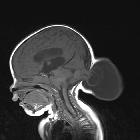chiari malformation




Chiari malformations are a group of defects associated with congenital caudal 'displacement' of the cerebellum and brainstem.
Classification
Initial descriptions were based on autopsy observations. Three types were described, with others added later. Types II and III are thought to be related to each other while type I represents a distinct entity .
- Chiari I malformation
- most common
- peg-like cerebellar tonsils displaced into the upper cervical canal through the foramen magnum
- Chiari 1.5 malformation
- described in the literature as both a condition in its own right as well as a variant of Chiari I malformation
- caudal descent of cerebellar tonsils and brain stem
- Chiari II malformation
- displacement of the medulla, fourth ventricle, and cerebellar vermis through the foramen magnum
- usually associated with a lumbosacral spinal myelomeningocele
- Chiari III malformation
- features similar to Chiari II, but with an occipital and/or high cervical encephalocele
- Chiari IV malformation
- severe cerebellar hypoplasia without displacement of the cerebellum through the foramen magnum
- probably a variation of cerebellar hypoplasia
- Chiari V malformation
- absent cerebellum
- herniation of the occipital lobe through the foramen magnum
- Chiari 0 malformation
- syrinx without cerebellar tonsillar, or brain stem descent
- infrequently used and confusing term to be avoided
- based on reports of syrinx improvement after posterior fossa decompression
- syrinx without cerebellar tonsillar, or brain stem descent
Treatment and prognosis
The main objective of surgery in Chiari malformation is to improve CSF flow across the foramen magnum and surrounding the brainstem, reduce the extent of the syrinx, and reduce pressure on the brainstem .
History and etymology
It was first described by Hans Chiari (1851-1914), an Austrian pathologist, in 1891 . In this and subsequent papers, Chiari also credited Julius Arnold (1835-1915), Professor of Anatomy at Heidelberg, on the grounds of a previous publication of a case believed by Arnold to be of a Chiari II malformation. It appears that this is not actually the case, and as such the term Arnold-Chiari to denote Chiari II malformations is no longer advocated .
Siehe auch:
- Chiari-Malformation Typ 1
- Basiläre Impression
- Arnold-Chiari-Malformation Typ 2
- Myelomeningozele
- Tiefstand der Kleinhirntonsillen
- Chiari 1.5 malformation
- Chiari-Malformation Typ 3
- Chiari-Malformation Typ 4
und weiter:

 Assoziationen und Differentialdiagnosen zu Chiari-Malformation:
Assoziationen und Differentialdiagnosen zu Chiari-Malformation:




